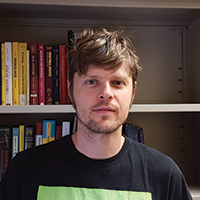
Alumnus Stuart Rogers works on the science behind rolling ball robots, like BB-8 from Star Wars: The Force Awakens. (© & ™ Lucasfilm Ltd.)
If a single quality could be attributed to all great mathematicians, it would have to be an insatiable appetite for problems that need to be solved.
After five years working in industry as an electrical engineer at Lockheed Martin in radar signal processing, it was time for Stuart Rogers ('17 PhD) to scratch a familiar itch.
With four degrees already under his belt- a bachelor's each in mathematics and computer science from Brown, along with a pair of master's in each of mathematics and electrical engineering from Brown and Old Dominion respectively-Rogers finally had a PhD-worthy problem.
Only a handful of researchers in North America were active in his interest area of geometric mechanics and control, so it wasn't long before he connected with Vakhtang Putkaradze (mathematical and statistical sciences) to see if Putkaradze would be interested in supervising his PhD project. It was a solid match, with each party interested in the experience the other brought to the table.
Remote rolling ball sensors for environments far, far away
Rogers' PhD work at the University of Alberta focused on developing algorithms for controlling rolling ball robots. That's right-just like the iconic BB-8 character from Star Wars: The Force Awakens.
As it turns out, there's a lot of science packed into the little droid.
In addition to the obvious questions (how do the other characters understand BB-8's blips and beeps?), the yet-untapped scientific potential of rolling ball robots presents some exciting new technological and mathematical problems that are ripe for exploration.
Though the research area is still new in the literature, rolling ball robots are already showing promise in industry.
"If the robot has to operate in a very isolated environment, like in the polar caps, how do you recharge that robot as it moves around?"
"There are several researchers at Caltech and other universities who are looking at building these and making them move around," Rogers explains. "And there are some folks in industry interested in building and buying these and packing them with sensors to go operate in remote environments."
Though they may not stack up against their wheeled counterparts, when it comes to traversing rough terrain, rolling ball robots appear to have the advantage in energy efficiency when operating in unconventional locales.
"If the robot has to operate in a very isolated environment, like in the polar caps, how do you recharge that robot as it moves around?" asks Rogers. Indeed, in remote locations where solar power is virtually non-existent for months at a time, how to power these sensor-loaded robots is a crucial question.
It seems that the answer may be an ultra-lightweight rolling ball robot blowing in the wind. Researchers at Caltech have developed a rolling ball robot called Moball, a remote sensing robot with the prospect of being deployed to Earth's polar regions to gather environmental data from the most remote areas on the planet.
One innovation uniquely qualifying Moball for this mission is its lightweight spherical design, which enables it to harvest energy from surface winds using sliding magnets and to generate self-propulsion. The pioneering technology presents a handy alternative to solar energy in regions where the sun is not a reliable source, like at the South Pole-or on Mars.
So-when a rolling ball robot like Moball is not being blown around at the whim of surface winds, how is it operated? That's where Rogers' algorithmic problem comes in.
"If you want to move a robot that has wheels attached, it has been studied for so long, and it has been done so many times that there aren't really any open questions there. But this rolling ball robot, it's completely new."
Moving in every direction
For most people, controlling the movement of a traditional four-wheeled robot is relatively straightforward; the operation would be intuitive for anyone who has driven a car. However, a rolling ball robot's ability to move in any direction throws a big, spherical wrench into things.
"If you want to move a robot that has wheels attached, it has been studied for so long, and it has been done so many times that there aren't really any open questions there," says Rogers. "But this rolling ball robot, it's completely new."
Fortunately, open questions are kind of his thing.
The first issue to tackle, Rogers explains, is figuring out a method to actuate the motion. Without any wheels (much less a combustion engine), a rolling ball robot's movement can be initiated by changing the centre of mass inside the ball-a complicated mathematical challenge on its own. Then, once the actuation technique is decided, the next problem is developing an algorithm to make the robot move where you want it to, like between a pair of points while avoiding a pair of intermediate obstacles.
Rogers' doctoral work in this area culminated in two papers submitted to peer-reviewed journals and recognition in the form of several awards, including the prestigious Anton A. Cseuz Gold Medal in Mathematics, awarded by the Department of Mathematical and Statistical Sciences to a graduate student for exceptional academic achievement and research excellence.
"When Stuart defended [his thesis], everybody was so excited about the quality of his work that we wanted to nominate him for some type of award," says Putkaradze of his former student. "He was a great candidate, and I think he was a great choice-not because I'm his supervisor, but because he deserves it for his hard work."
Awarded at convocation, the Cseuz gold medal is purposely intended not to supplement tuition and research costs, but to acknowledge the exceptional work already done by students as they move on to the next stage of their careers. Since the nomination comes from the department, careful screening ensures that the medal is awarded to the most deserving student.
Despite the recognition he received in the form of the medal and associated cash award, the true prize for Rogers was the discovery of a hard-won solution to a formidable mathematical challenge. "Receiving the medal and the monetary award was very satisfying," he says, "But I don't do the research for the money or awards, I do it because I'm passionate about solving the problem and getting the solution."
Seeking out-of-the box solutions
Now an industrial post-doc at the University of Minnesota, Rogers splits his time between research at the Institute for Mathematics and its Applications (IMA) and work with the data science and optimization department of the American retail giant Target.
On the academic side at the IMA, Rogers gets to continue his PhD work on rolling ball robots and begin to explore his own solution to a mathematical classic: the falling cat problem.
In his other role at Target, he is delving into a complex optimization problem common to online retailers everywhere: box suite optimization, or how to reduce the amount of empty space shipped along with your online purchase.
"It appears to me that there is a recent effort on the part of these online retailers like Amazon, Walmart, and Target to hire a lot of these well-educated people from other areas of industry-such as aerospace, defence, and finance-or from academia to work on these optimization problems."
"The optimization problem is to design the dimensions of the shipping boxes to ensure that wasted space is a minimum," he explains.
The solution requires an algorithm to analyze vast amounts of historical order data and propose a suite of boxes with optimal dimensions.
This type of industry-driven research opportunity for new graduates appears to be blossoming as companies increasingly recognize the margin-expanding potential of brain-power.
"It appears to me that there is a recent effort on the part of these online retailers like Amazon, Walmart, and Target to hire a lot of these well-educated people from other areas of industry-such as aerospace, defence, and finance-or from academia to work on these optimization problems," says Rogers, noting that many people in his research group have been working there for less than three years. "There's a great deal of money in retail, and I think they realized you can increase your profits a huge amount just by optimizing little things."
With one foot in academia and the other in industry, he now has the best of both worlds and no shortage of challenging problems.
"In academia when you solve a problem, you submit a paper, and it furthers the academic community-but it often doesn't do much outside of that," he says. "So, when you go into industry and you solve some kind of problem that the company or the customer has, it feels good to solve a problem that benefits a much broader community."
